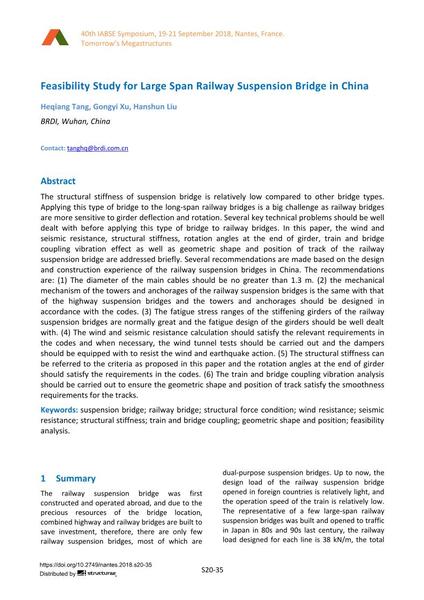Feasibility Study for Large Span Railway Suspension Bridge in China

|
|
|||||||||||
Détails bibliographiques
| Auteur(s): |
Heqiang Tang
(BRDI, Wuhan, China)
Gongyi Xu (BRDI, Wuhan, China) Hanshun Liu (BRDI, Wuhan, China) |
||||
|---|---|---|---|---|---|
| Médium: | papier de conférence | ||||
| Langue(s): | anglais | ||||
| Conférence: | IABSE Symposium: Tomorrow’s Megastructures, Nantes, France, 19-21 September 2018 | ||||
| Publié dans: | IABSE Symposium Nantes 2018 | ||||
|
|||||
| Page(s): | S20-35 | ||||
| Nombre total de pages (du PDF): | 7 | ||||
| DOI: | 10.2749/nantes.2018.s20-35 | ||||
| Abstrait: |
The structural stiffness of suspension bridge is relatively low compared to other bridge types. Applying this type of bridge to the long-span railway bridges is a big challenge as railway bridges are more sensitive to girder deflection and rotation. Several key technical problems should be well dealt with before applying this type of bridge to railway bridges. In this paper, the wind and seismic resistance, structural stiffness, rotation angles at the end of girder, train and bridge coupling vibration effect as well as geometric shape and position of track of the railway suspension bridge are addressed briefly. Several recommendations are made based on the design and construction experience of the railway suspension bridges in China. The recommendations are: (1) The diameter of the main cables should be no greater than 1.3 m. (2) the mechanical mechanism of the towers and anchorages of the railway suspension bridges is the same with that of the highway suspension bridges and the towers and anchorages should be designed in accordance with the codes. (3) The fatigue stress ranges of the stiffening girders of the railway suspension bridges are normally great and the fatigue design of the girders should be well dealt with. (4) The wind and seismic resistance calculation should satisfy the relevant requirements in the codes and when necessary, the wind tunnel tests should be carried out and the dampers should be equipped with to resist the wind and earthquake action. (5) The structural stiffness can be referred to the criteria as proposed in this paper and the rotation angles at the end of girder should satisfy the requirements in the codes. (6) The train and bridge coupling vibration analysis should be carried out to ensure the geometric shape and position of track satisfy the smoothness requirements for the tracks. |
||||
| Mots-clé: |
pont suspendu pont ferroviaire
|
||||


